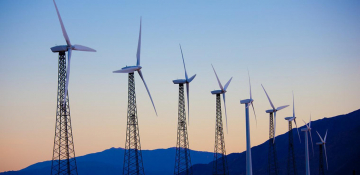Global energy generation is driven by a variety of sources. While fossil fuels are still by far the largest share of the market, renewables are the fastest growing as both efficiencies in renewable generation and consumer demand for more sustainable sources of energy increase. Overall demand for energy has rebounded after the unprecedented bottoming out of the energy sector in 2020. Forecasts indicate that with this boom in demand, energy consumption will outpace the anticipated growth in renewables for the immediate future.
All of this is happening against the backdrop of international efforts to reduce carbon emissions, the method widely acknowledged by climatologists and governments as most effective for slowing the rise of global temperatures.
One way many energy producers and consumers are taking part in this carbon reduction effort is through energy transition.
Bill MacDonald, Energy Transition Leader for Antea Group USA, sat down with us for a conversation about what energy transition is and what it means for the global energy sector. That conversation informed the contents of this post.
What Is Energy Transition?
A period of energy transition is defined by the adoption of a new primary energy system. It is not an immediate change nor a full-out replacement of existing energy systems.
Energy transition is a structural change, meaning technologies are developed and/or adapted to capture, convert, and transmit this new source of energy. As the name implies, energy transitions take place over time, as any new infrastructure required takes time to design and implement.
Historically, energy transitions have taken place when demand for energy outpaced existing resources. The stress on forest resources in Elizabethan England launched the western energy transition to coal-generated heating. The Industrial Revolution saw an even greater demand for energy, and natural gas was leveraged to light cities at night.
These transitions created additional energy systems but did not wholly eliminate existing ones. If you have a wood-fired stove in your home, you have an energy system that has been keeping humanity warm for millenia.
What are the components of an energy system?
Energy systems are the systems by which source material is extracted or harnessed, converted to energy, and transmitted to the end-user.
Within each energy system, the extraction or harnessing is unique to the energy source. Most energy consumed today is created by fossil fuels. These source materials are extracted from the ground, and at times require an additional step of refinement before they can be converted into energy. Other sources, such as geothermal, wind, and solar, exist continuously in nature and must have their inherent energy harnessed to convert into transmittable energy.
The transmission of energy to end-users is where each of these energy systems typically converge, although some sources like wind or solar can be harnessed and converted to electricity on a smaller scale at point-of-use.
As new energy sources are developed, it is most practical for them to tie in to existing transmission systems, and for those systems to be maintained to keep up with growing demand.
Which energy systems are in wide use globally?
A number of factors contribute to worldwide energy demand: emerging economies, local resources, technological advancements, and consumer behaviors to name a few. These demands, in turn, have an impact on which energy systems are most utilized.
The most recent statistics still show fossil fuels provide around 80% of all energy in the world, followed by nuclear, biofuels, and renewables.
As economies recover from the global pandemic, experts predict surges in fossil fuel demand that may nearly offset the carbon savings of 2020. Still, the renewable energy sector is continuing to surge, with wind and solar in the lead.
How are energy producers taking part in energy transition?
Energy producers understand the urgency of the moment and the need for reduced carbon emissions. There is an effort on the part of many utility companies to diversify the sources of energy they offer to consumers. Some utilities have even become energy producers, establishing their own networks of solar and wind energy.
While the transition to broader use of renewable energy is underway, legacy energy sources are still in high demand. Oil and gas producers will continue to play a large role in this transition period, and for many companies, that means looking at their own energy systems and making changes to reduce emissions from production.
The Outlook for Energy Transition
Private and corporate consumer demand for renewable energy continues to rise. As technology improves in both the production of renewable energy and the decarbonization of legacy energy sources, there is real hope that this energy transition could make an impact in stemming the rise of global temperatures. But the cost of transition will be high as companies and industries adapt and even re-invent themselves, and infrastructure enhancement occurs.
At the conclusion of our conversation, Bill shared what energy transition means for Antea Group: “Moving forward, Antea Group USA will focus on this broader energy landscape. While many of our existing consulting services will remain relevant, we will evolve them and make specific investments in new offerings that support our clients’ transition needs such as environmental, social, and governance consulting, merger and acquisition due-diligence support, construction safety, safety management program development, and the decommissioning of obsolete assets.”
Bill added, “We will work with our broader industry segments and clients to identify opportunities to support them as part of the energy transition supply chain, and as energy consumers.”
Learn how Antea Group can help your organization with Energy Management.
For more, connect with Bill MacDonaldWant more news and insights like this?
Sign up for our monthly e-newsletter, The New Leaf. Our goal is to keep you updated, educated, and even a bit entertained as it relates to all things EHS and sustainability.
Get e-NewsletterHave any questions?
Contact us to discuss your environment, health, safety, and sustainability needs today.







